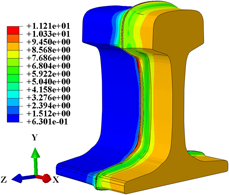Crossref Citations
This article has been cited by the following publications. This list is generated based on data provided by
Crossref.
Ma, Rui
Huang, Dan
Zhang, Jiao
Zhang, Yang
and
Lv, Qibing
2020.
Effects of rail flash-butt welding and post-weld heat treatment processes meeting different national standards on residual stresses of welded joints.
International Journal of Materials Research,
Vol. 111,
Issue. 9,
p.
780.
Wang, Xiao
Liu, Xin
Zhang, Jiao
Deng, Jiarong
and
Lv, Qibing
2022.
Numerical simulation of end face heating in alternating current flash butt welding based on electrical–thermal bidirectional coupling.
The International Journal of Advanced Manufacturing Technology,
Vol. 120,
Issue. 1-2,
p.
173.
Fang, Xiu-Yang
Zhang, Hao-Nan
Ma, Dong-Wen
Wu, Ze-Jian
and
Huang, Wei
2022.
Influence of welding residual stress on subsurface fatigue crack propagation of rail.
Engineering Fracture Mechanics,
Vol. 271,
Issue. ,
p.
108642.
Pang, Yong
Grilli, Nicolò
Su, Hang
Liu, Wencheng
Ma, Jun
and
Yu, Siu Fung
2022.
Experimental investigation on microstructures and mechanical properties of PG4 flash-butt rail welds.
Engineering Failure Analysis,
Vol. 141,
Issue. ,
p.
106650.
Wang, Jun
Lu, Yao
Han, Jian
Qi, Jianjun
Sun, Li
Jiang, Zhengyi
Ma, Cheng
and
Linton, Valerie
2022.
Study on microstructure evolution and mechanical properties of high-strength low-alloy steel welds realized by flash butt welding thermomechanical simulation.
The International Journal of Advanced Manufacturing Technology,
Vol. 122,
Issue. 2,
p.
639.
Li, J.
Doh, S. I.
and
Manogaran, R.
2023.
Detection and Maintenance for Railway Track Defects: A Review.
IOP Conference Series: Earth and Environmental Science,
Vol. 1140,
Issue. 1,
p.
012011.
Wang, Xiao
Chen, Hui
Zhu, Zongtao
Hao, Meiqi
Tan, Hongtao
Pei, Yuhu
and
Lv, Qibing
2024.
Simulation of nonuniform heating induced by alternating-current rail flash butt welding at the end face.
Welding in the World,
Vol. 68,
Issue. 10,
p.
2735.
Alves, Luiz Henrique Dias
Pereira, Henrique Boschetti
Echeverri, Edwan Anderson Ariza
Rezende, Iran José
Souza, Ricardo
Flores, Wagner Duarte
Tressia, Gustavo
and
Goldenstein, Hélio
2024.
Influence of Rail Metallurgy and Welding Parameterization on the Quality of Flash Butt Welds Done with Mobile Equipment.
Materials Research,
Vol. 27,
Issue. ,
Yang, Bo
Deng, Jiarong
Liu, Xin
Wang, Xiao
and
Lv, Qibing
2024.
Numerical Model of Rail Flash Welding Liquid Bridge Heating Process.
Transactions of the Indian Institute of Metals,
Vol. 77,
Issue. 4,
p.
1161.
